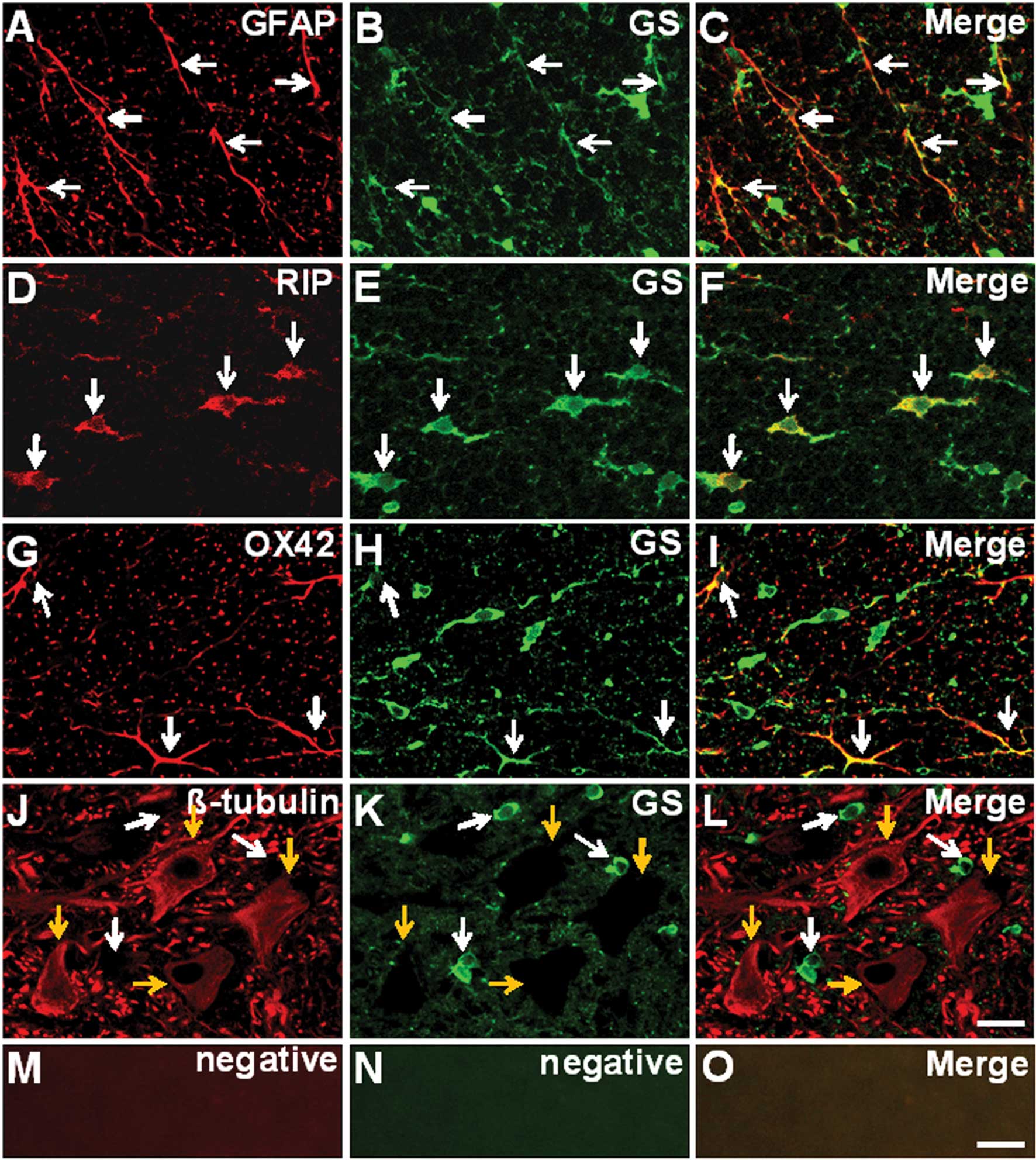|
1
|
Mills CD, Xu GY, McAdoo DJ and Hulsebosch
CE: Involvement of metabotropic glutamate receptors in excitatory
amino acid and GABA release following spinal cord injury in rat. J
Neurochem. 79:835–848. 2001. View Article : Google Scholar : PubMed/NCBI
|
|
2
|
Suárez I, Bodega G and Fernández B:
Glutamine synthetase in brain: effect of ammonia. Neurochem Int.
41:123–142. 2002.
|
|
3
|
Zou J, Wang YX, Dou FF, et al: Glutamine
synthetase down-regulation reduces astrocyte protection against
glutamate excitotoxicity to neurons. Neurochem Int. 56:577–584.
2010. View Article : Google Scholar : PubMed/NCBI
|
|
4
|
Xu B, Xu ZF, Deng Y, Liu W, Yang HB and
Wei YG: Protective effects of MK-801 on methylmercury-induced
neuronal injury in rat cerebral cortex: involvement of oxidative
stress and glutamate metabolism dysfunction. Toxicology.
300:112–120. 2012. View Article : Google Scholar
|
|
5
|
Silver J and Miller JH: Regeneration
beyond the glial scar. Nat Rev Neurosci. 5:146–156. 2004.
View Article : Google Scholar : PubMed/NCBI
|
|
6
|
Zou J, Wang YX, Mu HJ, et al:
Down-regulation of glutamine synthetase enhances migration of rat
astrocytes after in vitro injury. Neurochem Int. 58:404–413. 2011.
View Article : Google Scholar : PubMed/NCBI
|
|
7
|
Baldwin SA, Broderick R, Blades DA and
Scheff SW: Alterations in temporal/spatial distribution of GFAP-
and vimentin-positive astrocytes after spinal cord contusion with
the New York University spinal cord injury device. J Neurotrauma.
15:1015–1026. 1998. View Article : Google Scholar : PubMed/NCBI
|
|
8
|
Benton RL, Ross CD and Miller KE:
Glutamine synthetase activities in spinal white and gray matter 7
days following spinal cord injury in rats. Neurosci Lett. 291:1–4.
2000. View Article : Google Scholar : PubMed/NCBI
|
|
9
|
Romero-Alemán MM, Monzón-Mayor M, Yanes C
and Lang D: Radial glial cells, proliferating periventricular
cells, and microglia might contribute to successful structural
repair in the cerebral cortex of the lizard Gallotia
galloti. Exp Neurol. 188:74–85. 2004.
|
|
10
|
Lu HZ, Wang YX, Zou J, et al:
Differentiation of neural precursor cell-derived oligodendrocyte
progenitor cells following transplantation into normal and injured
spinal cords. Differentiation. 80:228–240. 2010. View Article : Google Scholar
|
|
11
|
Lü HZ, Xu L, Zou J, et al: Effects of
autoimmunity on recovery of function in adult rats following spinal
cord injury. Brain Behav Immun. 22:1217–1230. 2008.PubMed/NCBI
|
|
12
|
Hu JG, Fu SL, Zhang KH, et al:
Differential gene expression in neural stem cells and
oligodendrocyte precursor cells: a cDNA microarray analysis. J
Neurosci Res. 78:637–646. 2004. View Article : Google Scholar : PubMed/NCBI
|
|
13
|
Eid T, Behar K, Dhaher R, Bumanglag AV and
Lee TS: Roles of glutamine synthetase inhibition in epilepsy.
Neurochem Res. 37:2339–2350. 2012. View Article : Google Scholar : PubMed/NCBI
|
|
14
|
Chrétien F, Vallat-Decouvelaere AV,
Bossuet C, et al: Expression of excitatory amino acid transporter-2
(EAAT-2) and glutamine synthetase (GS) in brain macrophages and
microglia of SIVmac251-infected macaques. Neuropathol Appl
Neurobiol. 28:410–417. 2002.PubMed/NCBI
|
|
15
|
Caldani M, Rolland B, Fages C and Tardy M:
Glutamine synthetase activity during mouse brain development.
Experientia. 38:1199–1202. 1982. View Article : Google Scholar : PubMed/NCBI
|
|
16
|
Coulter DA and Eid T: Astrocytic
regulation of glutamate homeostasis in epilepsy. Glia.
60:1215–1226. 2012. View Article : Google Scholar : PubMed/NCBI
|
|
17
|
Moore CS and Crocker SJ: An alternate
perspective on the roles of TIMPs and MMPs in pathology. Am J
Pathol. 180:12–16. 2012. View Article : Google Scholar : PubMed/NCBI
|
|
18
|
Saitoh F and Araki T: Proteasomal
degradation of glutamine synthetase regulates schwann cell
differentiation. J Neurosci. 30:1204–1212. 2010. View Article : Google Scholar : PubMed/NCBI
|
|
19
|
Shaked I, Ben-Dror I and Vardimon L:
Glutamine synthetase enhances the clearance of extracellular
glutamate by the neural retina. J Neurochem. 83:574–580. 2002.
View Article : Google Scholar : PubMed/NCBI
|
|
20
|
Yan P, Liu N, Kim GM, et al: Expression of
the type 1 and type 2 receptors for tumor necrosis factor after
traumatic spinal cord injury in adult rats. Exp Neurol.
183:286–297. 2003. View Article : Google Scholar : PubMed/NCBI
|
|
21
|
Wang XF, Huang LD, Yu PP, et al:
Upregulation of type I interleukin-1 receptor after traumatic
spinal cord injury in adult rats. Acta Neuropathol. 111:220–228.
2006. View Article : Google Scholar : PubMed/NCBI
|
|
22
|
Xie Z, Smith CJ and Van Eldik LJ:
Activated glia induce neuron death via MAP kinase signaling
pathways involving JNK and p38. Glia. 45:170–179. 2004. View Article : Google Scholar : PubMed/NCBI
|
|
23
|
Lang B, Liu HL, Liu R, Feng GD, Jiao XY
and Ju G: Astrocytes in injured adult rat spinal cord may acquire
the potential of neural stem cells. Neuroscience. 128:775–783.
2004. View Article : Google Scholar : PubMed/NCBI
|
|
24
|
Politis MJ and Miller JE: Post-traumatic
alterations in glutamine synthetase activity in peripheral and
central nerves. Brain Res. 359:183–186. 1985. View Article : Google Scholar : PubMed/NCBI
|
|
25
|
Egnaczyk GF, Pomonis JD, Schmidt JA, et
al: Proteomic analysis of the reactive phenotype of astrocytes
following endothelin-1 exposure. Proteomics. 3:689–698. 2003.
View Article : Google Scholar : PubMed/NCBI
|
|
26
|
Levy HL: Metabolic disorders in the center
of genetic medicine. N Engl J Med. 353:1968–1970. 2005. View Article : Google Scholar : PubMed/NCBI
|
|
27
|
Takeuchi H, Jin S, Wang J, et al: Tumor
necrosis factor-alpha induces neurotoxicity via glutamate release
from hemichannels of activated microglia in an autocrine manner. J
Biol Chem. 281:21362–21368. 2006. View Article : Google Scholar : PubMed/NCBI
|













